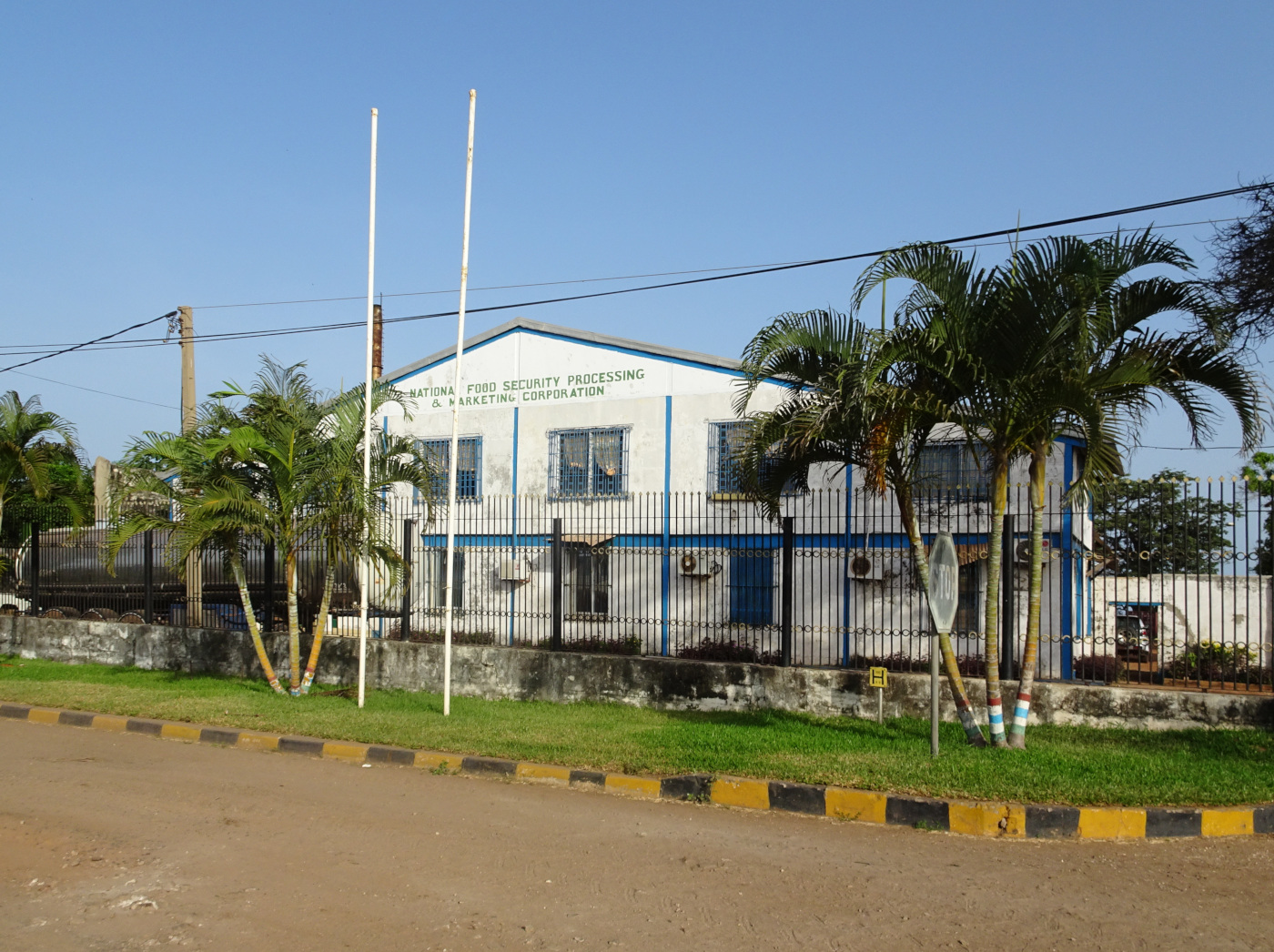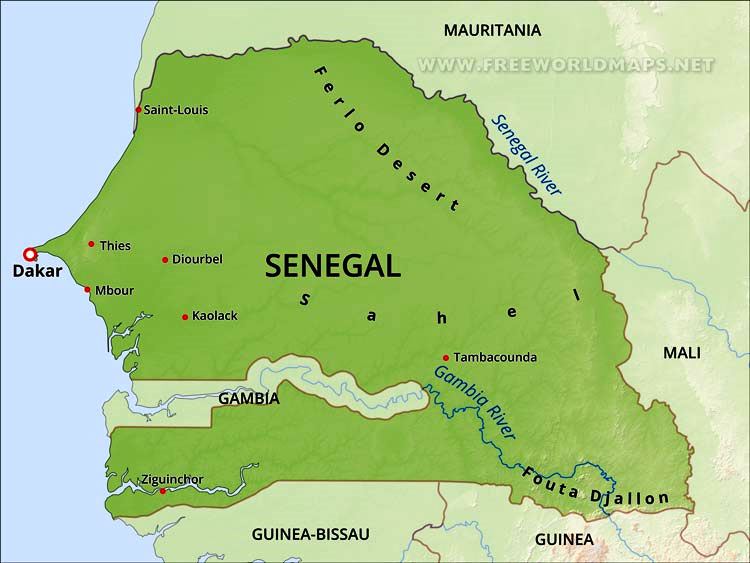Behind this unassuming façade below that houses The Gambia’s National Food Security, Processing and Marketing Corporation (NFSPMC), a quiet revolution is slowly but steadily gaining ground…

The Gambia continues to make great strides towards aflatoxin safety in groundnuts, mostly thanks to the National Food Security, Processing and Marketing Corporation (NFSPMC), that considers food safety as an integral part of food security which is its mandate. We recently sat down with Anthony Carvalho, NFSPMC Managing Director; Mustapha Colley, Deputy Managing Director; and Patrick Jarju, Head of the Chemistry and Biological Laboratory, for a chat on where NFSPMC is in fighting aflatoxin, and future plans. Here’s how that went down…
Tell us about food safety in The Gambia, particularly on aflatoxin
Recognising that aflatoxin could be a real and present danger in The Gambia, we did our homework and read up on the subject
We learnt of the aflatoxin-related deaths in Kenya widely reported in the mass media. Though happening far from our shores, we took a realistic and pragmatic approach: recognising that aflatoxin could be a real and present danger in The Gambia as well, we did our homework and read up on the subject. This is how we came to contact IITA. Jointly, we started working on both the problem of aflatoxin and the solutions in 2013/2014.
Awareness on aflatoxin is deplorably very low in The Gambia. People are not aware that some of the food they’ve been eating all their lives could contain poison. And even when people die from aflatoxin poisoning, it escapes notice as we really do not interrogate how people die
Still, even now five and more years on, awareness on aflatoxin is deplorably very low in The Gambia. People are not aware that some of the food they’ve been eating all their lives could contain poison. And even when people die from aflatoxin poisoning, it escapes notice as we really do not interrogate how people die. We need to communicate much more on the dangers of aflatoxin, and to do this continuously: FM and community radio would be a very effective tool for this. On trade, we’ve lost the European Union market due to aflatoxin, though we’re now gradually gaining ground again in that lucrative market.
How is NFSPMC tackling the problem of aflatoxin in The Gambia?
By actively participating in and encouraging awareness campaigns by the Ministry of Agriculture, the Food Safety and Quality Authority, other government and non-government agencies concerned about food safety such as the Ministry of Trade, Gambia Investment and Export Promotion Agency and the Partnership for Aflatoxin Control in Africa.
For our part, we have been distributing Aflasafe directly to farmers as part of a package of good agricultural practices to stem aflatoxin. How we do this has also been changing as we expand our programme. Initially, we distributed Aflasafe to groundnut farmers entirely for free in early pilot programmes, through The Gambia Groundnut Corporation [GGC] which is our former name. We still do, but on a larger scale with funding from the Islamic Trade and Finance Corporation [ITFC] of the Islamic Development Bank.
As an incentive, NFSPMC offers a premium price for these Aflasafe-treated groundnuts
As an incentive, NFSPMC offers a premium price for these Aflasafe-treated groundnuts, paying 2.1 dalasis more per kilo. We plan to thereafter move to a staggered subsidy programme at 50%, still with ITFC funding, with a view to eventually phasing out the subsidies altogether, as we move from piloting to full market-based rollout for Aflasafe in The Gambia. We’re taking this graduated stepwise manner to ensure that things are done properly for sustainable food safety. Our first focus is The Gambia’s groundnut belt, but we plan to eventually cover groundnuts countrywide. We first needed strategies that would allow for rapid purchase of Aflasafe and to get it into the hands of farmers as quickly as possible. And so, we bought 50 tonnes for the 2018 season, and plan to buy at least another 50 for the 2019 season.
Our free Aflasafe distribution began in 2015. We plan to thereafter move to a staggered Aflasafe subsidy programme … with a view to eventually phasing out the subsidies altogether … We’re taking this graduated stepwise manner to ensure that things are done properly for sustainable food safety
Another reason for our evolving strategy on Aflasafe is sustainability through a carefully managed process geared towards a free-market approach. We are working with – or encouraging – farmer cooperative movements to help with both Aflasafe distribution and purchase of Aflasafe-treated groundnuts. This aggregation and integration makes things much easier and more efficient. It also eases awareness, sensitisation and training of trainers.
Our free Aflasafe distribution began in 2015, one year after our neighbours in Senegal. But we first conducted a two-year trial run of our own so that we could be sure the product works before buying Aflasafe to give to farmers. We deliberately picked the groundnut belt whose northern part borders Senegal and is naturally also contiguous to Senegal’s own groundnut belt.
How do you assure quality control for aflatoxin safety, how many farmers are you working with, and how do you select them?

For quality control and assurance, we test for aflatoxin when buying back from Aflasafe-using farmers, with ITFC-funded test kits, and technical support from IITA. Test results get better and better, posting a 90 to 98% reduction on aflatoxin. Between 2014 and 2017, 80% of the groundnuts we tested had 0–4 ppb [parts per billion] of aflatoxin while 19% had between 5 and 20 ppb, meaning 99% of the stock met the threshold of lucrative export markets in the EU [European Union] and USA.
Test results get better and better, posting a 90 to 98% reduction on aflatoxin. Between 2014 and 2017, 80% of the groundnuts we tested had 0–4 parts per billion of aflatoxin while 19% had between 5 and 20 ppb, meaning 99% of the stock met the threshold of lucrative export markets in the EU and USA. And yet these were the regions that had the highest aflatoxin contamination, not less than 500 ppb when we did the baseline study
And yet these were the regions that had the highest aflatoxin contamination, not less than 500 ppb when we did the baseline study. IITA advised that we first start where the problem was worst, and so the three regions that had the highest aflatoxin levels have now been Aflasafe-treated for four consecutive years. And we see the fruits of this labour. Results from 2018 showed less than 4 ppb, and in fact averaging 2–3 ppb. One good thing is that we would not be starting completely from scratch, as The Gambia still has a toehold in the EU market which was not entirely lost despite aflatoxin. But Aflasafe is the game-changer that will help us expand our market share. We’ve already made contacts with the market on aflatoxin-safe quantities expected, which we will be exporting in the course of 2019.
We see the fruits of this labour. Results from 2018 showed less than 4 ppb, and in fact averaging 2–3 ppb … Aflasafe is the game-changer that will help us expand our market share. We’ve already made contacts with the market on aflatoxin-safe quantities expected, which we will be exporting in the course of 2019 … On average, meeting aflatoxin safety for external markets adds about 35% to the selling price
Thus far, we’re working with 700 households, which is equivalent to about 7,000 farmers across our three focus regions. We use several criteria in selecting farmers. First and foremost, we target the groundnut belt. During the trial period, farmer selection was fairly random. We have since become more strategic. We take into account farm size, accessibility for monitoring, and the farmers must have participated in the Aflasafe application training as well as in aflatoxin community sensitisation by the Ministry of Agriculture’s extension staff. They must also be members of a farmer co-operative, for ease of aggregation and buy-back at designated collection points.
We reward farmers who apply Aflasafe by offering them 2.1 dalasi above the market price. For the export market, price is not just determined by aflatoxin safety but also by the size of the kernels or grains: the fewer the number of grains to the weight, the higher the price. So, 38–40 grains per hundred grammes will fetch more than 50– 60 grains. On average, meeting aflatoxin safety for external markets adds about 35% to the selling price.
Great! What are your future plans?
Our strategy is safe food for all internally and externally, and Aflasafe is an integral part of this strategy. The goal is to expand our external market while also assuring safe food for Gambians at home … We aim to cover the entire country with Aflasafe by 2021
Our strategy is safe food for all internally and externally, and Aflasafe is an integral part of this strategy. The goal is to expand our external market while also assuring safe food for Gambians at home. For this, were working with external partners such as ITFC, the EU’s Enhanced Integrated Framework and TIKA [Turkish Cooperation and Coordination Agency].
And to get us there, as mentioned earlier, we aim to cover the entire country with Aflasafe by 2021. Our 2019 target is an additional 50 tonnes of Aflasafe for a new region that we have not yet covered.
LINKS
- Perspectives from collaborating farmers:
- Previous news items from us:
- Farmer and consumer voices on Aflasafe SN01, beyond beating aflatoxin in food in The Gambia
- ’Tis the season for going nuts in The Gambia and Senegal: Protecting groundnuts from aflatoxin with Aflasafe SN01
- Business-to-business interactions to spur and sustain Aflasafe SN01 demand in Senegal and The Gambia (English | French)
- Latest strides in Senegal and The Gambia in commercialising Aflasafe – one user’s experience
- Technology leap for Senegal and The Gambia to combat aflatoxin in food (English | French)
- Keep updated on Aflasafe in The Gambia










